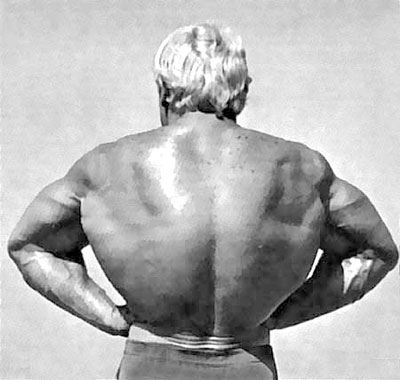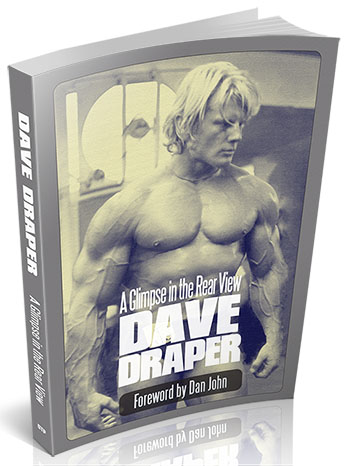Strengthening the Back

Download the full Draper here newsletter
in printable, live-link, pdf format, here.
An IronOnline reader writes, “I’m fifty years old. I was really into bodybuilding 30 years ago. In the past I was mostly injury-free, but now I’m having a lot of problems with my lower back. Doing deadlifts, stiff-legged deadlifts or bentover rows invariably strain my lower back, setting my progress back. How can I strengthen this area so I can avoid these injuries?”
Howdy, Sonny... I say this with a gravelly voice, slightly bent over, leaning on a handsome, twisted-burl walking stick.
The lower back needs to be looked upon as an investment in your future. We all agree that our muscle building, heart, lungs and flexibility in general are on that list, but the lower back bears the big load as we pursue the others. Be prepared to attend the area with special focus and deliberation... and patience.
In repairing any injury or a weakened area due to under-use, I have eventually accepted that very light weights with concentrated increases in resistance, over time, healed and strengthened the area, while teaching me the lessons of focus, humility, struggle, good pain-bad pain and gratefulness.
Of course, I’d rather be made of non-corrosive iron and steel and titanium, and forget about the character traits, but I hear they can be useful.
Before working out, apply yourself to some light and then vigorous stationary cycling to raise your core temperature -- with a vulnerable low back, avoid impact aerobics, the treadmill and even the torque of the StairMaster. Give yourself 10 minutes of planks and their variety, supersetted with rope tucks to attend the mid-section and warm up the lower back region. All this is valuable in building the heart and lung, torso and mid-section and prepares you for some respectable lower back therapy and development.
Let’s start.
Can you do hyperextensions? They’re a good lower back insurance to work in twice a week with your mid-section routine -- three sets of 12-15 reps with no weight performed between hanging leg raises or rope tucks. Just hang freely over the apparatus and slowly draw yourself up with muscle action to a degree worthy of comfortable effort. Return to the hanging position and repeat with curiosity and growing confidence as you seek your range of motion and discover your ability.
This isn’t chicken training; it’s caution with your eye on bigger things soon. Get in your reps and be tough yet wise as you complete your sets from workout to workout. Don’t over-arch or swing into a contracted top position through momentum, thus aggravating your spine... use muscle only with regulated might.
Put the stiff-leg deadlifts aside for now, and save the power-style deadlifts for another time. What that leaves you is a safer, combined version of the two. Set up an empty Olympic bar on a rack just above knee level, or you can work off a bench end to eliminate the awkward access from the floor. Grab the bar as you do when practicing deadlifts, step back precisely from the rack and stand erect.
Now, keeping the bar close to the body, consciously extend your butt backwards as you slightly let the knees bend while you lower your body, all radar scanning for hints of pain and the red-zone.
You’re not bound by proper lifting form as taught in Weight-Lifting 1A by some thickheaded, no-neck guy with a crew cut and hefty butt. You’re the instructor and the student, and this is your class. It’s advanced and you can develop the style as you please -- let pain be your guide, guts your partner and instinctive wisdom your coach.
Get in some slow and deliberate reps -- 12 is good -- to familiarize your knees and grip and footing as you seek out a range of motion. Be happy and don’t expect too much on the first set, especially with a weight too light to establish any sort of groove.
Add a 10 to each side, plus or minus according to your needs and how you feel, and go again, applying your breathing technique like this is real ’cuz it is. Inch your way down as you freelance the movement to suit the body of a person lowering and lifting a pleasantly bulky weight.
Keep the back flattish rather than roundish... think hips, butt, thighs, bar close, head straight and eyes looking in a straight line from the body. If you can achieve a mid-tibia depth, you’re in good shape.
Another 12 reps and you can move up again. Forget the big wheels that once hung off the sides of the bar not that long ago. Today you’re snooping around the foothills looking for a nearby path to the mountaintop. Won’t be long before you can see forever.
I’ve always been a punk, so I’d probably go up in weight for a total of five sets. What you do here in developing your lower back is not designed to satisfy your aggressive muscle-building aspirations. Busy yourself elsewhere with that -- chest, bis, tris -- and be content that you’re securing and readying your back for bigger things to come... soon enough.
Progress slowly and thoughtfully, and you’ll be amazed at how quickly progressive weight training will do its good work.
I know I presented the kindergarten strategy to a man a half-century old, but it’s the only one I personally understand.
Your brother, Dave
*****
You don’t have to sign up for Facebook to read Dave’s commentary and interactions on his Facebook page. Dave is on Facebook here:
http://www.facebook.com/bodybuilderdavedraper
Dave is on Twitter, here:
---
Take a trip over to our
Musclebuilding Q&A Blog
... where Dave allows us a peek into his email outbox.
Did you sign up for Dave's expanded email yet?
It's free, motivating and priceless!
We'll also send you a link to Dave's free
Body Revival Tips and Hints e-report with your confirmation notice.

